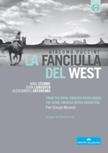|
Back
10/13/2013
Giacomo Puccini: La fanciulla del West
Nina Stemme (Minnie), Aleksandrs Antonenko (Dick Johnson/Ramerrez), John Lundgren (Jack Rance), Niklas Björling Rygert (Nick), Michael Schmidberger (Ashby), Ola Eliasson (Sonora), Karl Rombo (Trin), Gunnar Lundberg (Sid), Linus Börjesson (Bello), Conny Thimander (Harry), Magnus Kyhle (Joe), Kristian Flor (Happy), Ian Power (Larkens), Alar Pintsaar (Billy Jackrabbit), Agneta Lundgren (Wowkle), John Erik Eleby (Jake Wallace), Anton Eriksson (José Castro), Jon Nilsson (The Pony Express Rider), The Royal Opera Male Chorus, Bo Wannefors (Chorus Master), Royal Swedish Opera Orchestra, Tomas Gustafsson (Concertmaster), Pier Giorgio Morandi (Conductor), Christof Loy (Stage Director), Herbert Murauer (Stage and Costume Designer), Thomas Wilhelm (Choreographer), Hannes Rossacher (Video Director)
Recorded at the Royal Swedish Opera House (February 2012) – 140’
Euro Arts/Unitel Classica #2072598 (or Blu-ray #2072594) (Distributed by Naxos of America) – Booklet in English, German and French – Subtitles in English, German, French, Italian, Spanish and Japanese

   
Talents of director Christof Loy and stage/costume designer Herbert Murauer have been a proven fortuitous duo in the past. Having witnessed their creations via review of Los Angeles Opera’s fabulous 2011 production of Il Turco in Italia (Read here), this new Swedish Royal Opera translation is definitely worth a ‘look see.’
Giacomo Puccini’s ‘Spaghetti Western’ has cinematic qualities quite literally with Loy opening in a black and white reel of film set against the ‘Introduction.’ Its innovativeness is especially attention getting when Nina Stemme (‘The Girl’) runs straight toward the stage and pops out of film, breaking through a barrier onto the stage. Rather clever. This thematic coursing of 35 millimeter projection pops up at significant Puccini segments. The booklet states, “Film elements pervade the entire opera”…not altogether true since this technique only lasts through Act II. Nowhere do we find this in Act III. It’s as though Loy and Murauer completely forgot about their original intentions. This continuity would have been a crowning touch by having hero and heroine walk back into the film. Personally, it provided an element of frustration.
Murauer’s staging is shallowly compacted which actually does two things which are in direct conflict to one another: firstly, it funnels the action into a specific space, allowing Thomas Wilhelm’s choreography of the miners to run on and off the stage in a rampant, thread-like fashion so as to create a bit of D.W. Griffith imagery, combined with Loy’s brilliant lighting that elicits imposing shadows. Secondly, this case of space is a bit claustrophobic, thus diminishing the magnification of energy that should run alongside these strings of powerful Puccini music. For example, in Act I we see two rooms in cross section. Minnie is in her own bedroom (about a quarter of the set), primping before she sets open the door with her big arrival. The grandiose entrance is deflated because she’s really hemmed in when stepping into the Polka Bar filled with a pack full of men (the remaining three-quarters of section.) But altogether the costuming and sets are innovative, minimal in scope, and allowing the viewer to focus attention on the characters themselves.
Minnie must have a voice that can project and deliver powerfully while up against the music. Pier Giorgio Morandi’s conducting is superb and detailed, and Nina Stemme possesses a perfect range to capture the essence of her protagonist role. The voice of Aleksandrs Antonenko has a lyrical softness, and he delivers quite the moving ‘pardon’ in his “Sono un dannato!” in the middle of Act II. The heft in John Lundgren’s baritone register has exceptional build as Jack Rance that turns him into a virile, imposing force; at times his facial expressions are vehement and rather terrifying. All of the minor character roles are well accentuated, especially that of Niklas Björling Rygert’s Nick. Agneta Lundgren has impish gestures as Wowkle while preparing for Dick Johnson’s arrival in the opening of Act II. La fanciulla del West calls for swells of melodrama, but the objective is underachieved.
Unitel Classica’s recording is unembellished. There are no great pauses or titles to delineate the acts. The approach assumes everyone knows the story. People who relish the wonderful sweeps in Puccini’s La fanciulla del West will likely enjoy the bit of freshness while riding down the old dusty trail...
Christie Grimstad
|